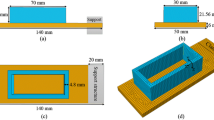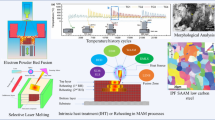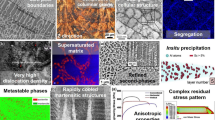Abstract
In additive manufacturing (AM), residual stresses and microstructural inhomogeneity are detrimental to the mechanical properties of as-built AM components. In previous studies, the reduction of the residual stresses and the optimization of the microstructure have been treated separately. Nevertheless, the ability to control both them at the same time is mandatory for improving the final quality of AM parts. This is the main goal of this paper. Thus, a thermo-mechanical finite element model is firstly calibrated by simulating a multi-track 40-layer Ti–6Al–4V block fabricated by directed energy deposition (DED). Next, the numerical tool is used to study the effect of the baseplate dimensions and the energy density on both residual stresses and microstructure evolution. On the one hand, the results indicate that the large baseplate causes higher residual stresses but produces more uniform microstructures, and contrariwise for the smaller baseplate. On the other hand, increasing the energy density favors stress relief, but its effect fails to prevent the stress concentration at the built basement. Based on these results, two approaches are proposed to control both the stress accumulation and the metallurgical evolution during the DED processes: (i) the use of a forced cooling suitable for small baseplates and, (ii) the adoption of grooves when large baseplates are used. The numerical predictions demonstrated the effectiveness of the proposed manufacturing strategies.























Similar content being viewed by others
References
Gu D, Shi X, Poprawe R, Bourell D, Setchi R, Zhu J (2021) Material-structure-performance integrated laser-metal additive manufacturing. Science. https://doi.org/10.1126/science.abg1487
Baiges J, Chiumenti M, Moreira CA, Cervera M, Codina R (2021) An adaptive finite element strategy for the numerical simulation of additive manufacturing processes. Addit Manuf 37:101650. https://doi.org/10.1016/j.addma.2020.101650
Xue A, Lin X, Wang L, Lu X, Ding H, Huang W (2021) Heat-affected coarsening of β grain in titanium alloy during laser directed energy deposition. Scripta Mater 205:114180. https://doi.org/10.1016/j.scriptamat.2021.114180
Lu X, Chiumenti M, Cervera M, Tan H, Lin X, Wang S (2021) Warpage analysis and control of thin-walled structures manufactured by laser powder bed fusion. Metals 11(5):686. https://doi.org/10.3390/met11050686
Zhao Z, Chen J, Lu X, Tan H, Lin X, Huang W (2017) Formation mechanism of the α variant and its influence on the tensile properties of laser solid formed Ti-6Al-4V titanium alloy. Mater Sci Eng A 691:16–24. https://doi.org/10.1016/j.msea.2017.03.035
Chiumenti M, Neiva E, Salsi E, Cervera M, Badia S, Moya J, Chen Z, Lee C, Davies C (2017) Numerical modelling and experimental validation in selective laser melting. Addit Manuf 18:171–185. https://doi.org/10.1016/j.addma.2017.09.002
Lu X, Lin X, Chiumenti M, Cervera M, Li J, Ma L, Wei L, Hu Y, Huang W (2018) Finite element analysis and experimental validation of the thermomechanical behavior in laser solid forming of Ti-6Al-4V. Addit Manuf 21:30–40. https://doi.org/10.1016/j.addma.2018.02.003
Cao Y, Lin X, Kang N, Ma L, Wei L, Zheng M, Yu J, Peng D, Huang W (2021) A novel high-efficient finite element analysis method of powder bed fusion additive manufacturing. Addit Manuf. https://doi.org/10.1016/j.addma.2021.102187
Lu X, Chiumenti M, Cervera M, Li J, Lin X, Ma L, Zhang G, Liang E (2021) Substrate design to minimize residual stresses in directed energy deposition AM processes. Mater Des 202:109525. https://doi.org/10.1016/j.matdes.2021.109525
Chiumenti M, Lin X, Cervera M, Lei W, Zheng Y, Huang W (2017) Numerical simulation and experimental calibration of additive manufacturing by blown powder technology. Part I: thermal analysis. Rapid Prototyp J 23(2):448–463. https://doi.org/10.1108/RPJ-10-2015-0136
Smith J, Xiong W, Cao J, Liu W (2016) Thermodynamically consistent microstructure prediction of additively manufactured materials. Comput Mech 57(3):359–370. https://doi.org/10.1007/s00466-015-1243-1
Denlinger E, Michaleris P (2016) Effect of stress relaxation on distortion in additive manufacturing process modeling. Addit Manuf 12:51–59. https://doi.org/10.1016/j.addma.2016.06.011
Wang Z, Stoica A, Ma D, Beese A (2017) Stress relaxation behavior and mechanisms in Ti-6Al-4V determined via in situ neutron diffraction: application to additive manufacturing. Mater Sci Eng A 707:585–592. https://doi.org/10.1016/j.msea.2017.09.071
Mukherjee T, Manvatkar V, De A, DebRoy T (2017) Mitigation of thermal distortion during additive manufacturing. Scripta Mater 127:79–83. https://doi.org/10.1016/j.scriptamat.2016.09.001
Lu X, Lin X, Chiumenti M, Cervera M, Hu Y, Ji X, Ma L, Yang H, Huang W (2019) Residual stress and distortion of rectangular and s-shaped Ti-6Al-4V parts by directed energy deposition: modelling and experimental calibration. Addit Manuf 26:166–179. https://doi.org/10.1016/j.addma.2019.02.001
Cao J, Gharghouri M, Nash P (2016) Finite-element analysis and experimental validation of thermal residual stress and distortion in electron beam additive manufactured Ti-6Al-4V build plates. J Mater Process Technol 237:409–419. https://doi.org/10.1016/j.jmatprotec.2016.06.032
Lu X, Cervera M, Chiumenti M, Li J, Ji X, Zhang G, Lin X (2020) Modeling of the effect of the building strategy on the thermomechanical response of Ti-6Al-4V rectangular parts manufactured by laser directed energy deposition. Metals 10(12):1643. https://doi.org/10.3390/met10121643
Chen W, Xu L, Han Y, Zhao L, Jing H (2021) Control of residual stress in metal additive manufacturing by low-temperature solid-state phase transformation: an experimental and numerical study. Addit Manuf 42:102016. https://doi.org/10.1016/j.addma.2021.102016
Hong M, Kim Y (2020) Residual stress reduction technology in heterogeneous metal additive manufacturing. Materials 13(23):5516. https://doi.org/10.3390/ma13235516
Zhao Z, Chen J, Tan H, Tang J, Lin X (2020) In situ tailoring microstructure in laser solid formed titanium alloy for superior fatigue crack growth resistance. Scripta Mater 174:53–57. https://doi.org/10.1016/j.scriptamat.2019.08.028
Lu X, Zhang G, Li J, Cervera M, Chiumenti M, Chen J, Lin X, Huang W (2021) Simulation-assisted investigation on the formation of layer bands and the microstructural evolution in directed energy deposition of Ti6Al4V blocks. Virtual Phys Prototyp. https://doi.org/10.1080/17452759.2021.1942077
Song T, Dong T, Lu SL, Kondoh K, Das R, Brandt M, Qian M (2021) Simulation-informed laser metal powder deposition of Ti-6Al-4V with ultrafine α-β lamellar structures for desired tensile properties. Addit Manuf 46:102139. https://doi.org/10.1016/j.addma.2021.102139
Wang J, Lin X, Li J, Hu Y, Zhou Y, Wang C, Li Q, Huang W (2019) Effects of deposition strategies on macro/microstructure and mechanical properties of wire and arc additive manufactured Ti6Al4 V. Mater Sci Eng A 754:735–749. https://doi.org/10.1016/j.msea.2019.03.001
Kürnsteiner P, Wilms MB, Weisheit A, Gault B, Jägle EA, Raabe D (2020) High-strength damascus steel by additive manufacturing. Nature 582(7831):515–519. https://doi.org/10.1038/s41586-020-2409-3
Chiumenti M, Cervera M, Moreira C, Barbat G (2021) Stress, strain and dissipation accurate 3-field formulation for inelastic isochoric deformation. Finite Elem Anal Des 192:103534. https://doi.org/10.1016/j.finel.2021.103534
Chiumenti M, Cervera M, Salmi A, Saracibar CA, Dialami N, Matsui K (2010) Finite element modeling of multi-pass welding and shaped metal deposition processes. Comput Methods Appl Mech Eng 199(37–40):2343–2359. https://doi.org/10.1016/j.cma.2010.02.018
Lu X, Lin X, Chiumenti M, Cervera M, Hu Y, Ji X, Ma L, Huang W (2019) In situ measurements and thermomechanical simulation of Ti-6Al-4V laser solid forming processes. Int J Mech Sci 153–154:119–130. https://doi.org/10.1016/j.ijmecsci.2019.01.043
Chiumenti M, Cervera M, Dialami N, Wu B, Jinwei L, Saracibar CA (2016) Numerical modeling of the electron beam welding and its experimental validation. Finite Elem Anal Des 121:118–133. https://doi.org/10.1016/j.finel.2016.07.003
Neiva E, Chiumenti M, Cervera M, Salsi E, Piscopo G, Badia S, Martín A, Chen Z, Lee C, Davies C (2020) Numerical modelling of heat transfer and experimental validation in powder-bed fusion with the virtual domain approximation. Finite Elem Anal Des 168:103343. https://doi.org/10.1016/j.finel.2019.103343
GiD, The Personal Pre and Post-Processor, CIMNE, Technical University of Catalonia, 2002. https://www.cimne.com/comet
Fallah V, Alimardani M, Corbin S, Khajepour A (2011) Temporal development of melt-pool morphology and clad geometry in laser powder deposition. Comput Mater Sci 50(7):2124–2134. https://doi.org/10.1016/j.commatsci.2011.02.018
Promoppatum P, Uthaisangsuk V (2021) Part scale estimation of residual stress development in laser powder bed fusion additive manufacturing of Inconel 718. Finite Elem Anal Des 189:103528. https://doi.org/10.1016/j.finel.2021.103528
Wu Q, Mukherjee T, Liu C, Lu J, DebRoy T (2019) Residual stresses and distortion in the patterned printing of titanium and nickel alloys. Addit Manuf 29:100808. https://doi.org/10.1016/j.addma.2019.100808
Wei H, Mukherjee T, Zhang W, Zuback J, Knapp G, De A, DebRoy T (2021) Mechanistic models for additive manufacturing of metallic components. Prog Mater Sci 116:100703. https://doi.org/10.1016/j.pmatsci.2020.100703
Yeung H, Lane B, Fox J (2019) Part geometry and conduction-based laser power control for powder bed fusion additive manufacturing. Addit Manuf 30:100844. https://doi.org/10.1016/j.addma.2019.100844
Carraturo M, Lane B, Yeung H, Kollmannsberger S, Reali A, Auricchio F (2020) Numerical evaluation of advanced laser control strategies influence on residual stresses for laser powder bed fusion systems. Integr Mater Manuf Innov 9(4):435–445. https://doi.org/10.1007/s40192-020-00191-3
Williams R, Piglione A, Rønneberg T, Jones C, Pham M, Davies C, Hooper P (2019) In situ thermography for laser powder bed fusion: effects of layer temperature on porosity, microstructure and mechanical properties. Addit Manuf 30:100880. https://doi.org/10.1016/j.addma.2019.100880
Mishurova T, Artzt K, Haubrich J, Requena G, Bruno G (2019) Exploring the correlation between subsurface residual stresses and manufacturing parameters in laser powder bed fused Ti-6Al-4V. Metals 9(2):261. https://doi.org/10.3390/met9020261
Li H, Ramezani M, Chen Z, Singamneni S (2019) Effects of process parameters on temperature and stress distributions during selective laser melting of Ti–6Al–4V. Trans Indian Inst Met 72(12):3201–3214. https://doi.org/10.1007/s12666-019-01785-y
Acknowledgements
This work was funded by the National Key R&D Program of China (No. 2016YFB1100100), the European KYKLOS 4.0 project: An Advanced Circular and Agile Manufacturing Ecosystem based on rapid reconfigurable manufacturing process and individualized consumer preferences (no. 872570), and the China Scholarship Council (no. 201906290011).
Author information
Authors and Affiliations
Corresponding authors
Ethics declarations
Conflict of interest
The author declares that they have no conflict of interest.
Additional information
Publisher's Note
Springer Nature remains neutral with regard to jurisdictional claims in published maps and institutional affiliations.
Rights and permissions
About this article
Cite this article
Lu, X., Chiumenti, M., Cervera, M. et al. Mitigation of residual stresses and microstructure homogenization in directed energy deposition processes. Engineering with Computers 38, 4771–4790 (2022). https://doi.org/10.1007/s00366-021-01563-9
Received:
Accepted:
Published:
Issue Date:
DOI: https://doi.org/10.1007/s00366-021-01563-9




